I solved a mystery recently, an Icelandic folk mystery.
Every time I plug my iPhone into any car other than my own car, Icelandic folk music stars playing.
Specifically, the song Á Ferð Til Breiðafjarðar, by Steindór Andersen and Sigur Rós, from the album Soundtrip Iceland starts playing.
This happens in Lisa’s Nissan Rogue. It happened in the BYD electric car we rented in France last year. It happened in the Citroën we rented in Italy this year. It happens enough that Lisa, L., and I can recite the first verse almost by heart.
But why? Why this song?
Here’s what I figured out: for reasons unknown, my iPhone, connected via Bluetooth to a non-Carplay-enabled car stereo system, defaults to playing Apple Music.
The music it defaults to playing is from my Apple Music library — it’s not streaming music, per se, but rather the albums that ended up, through various generations of iTunes and Apple Music, being ingested into my library from CD.
And, specifically, it defaults to playing the songs in the library, in alphabetical order of song title. The Icelandic letter Á happens to sort first in my library, so that’s why it plays first.
Á Ferð Til Breiðafjarðar is always followed by Abraham’s Theme (From Chariots of Fire), and so on, through the As, the Bs (Baba O’Riley, by The Who), the Cs (California by U2) and Ds (Das Berliner Requiem). And so on.
This is a motley collection of music, from different eras of my life, from different sources. I’m not certain I know how to get new items into this library, or take old items out. And I haven’t yet figured out how to change Apple Music’s default behaviour.
But I’m happy to have solved the mystery.
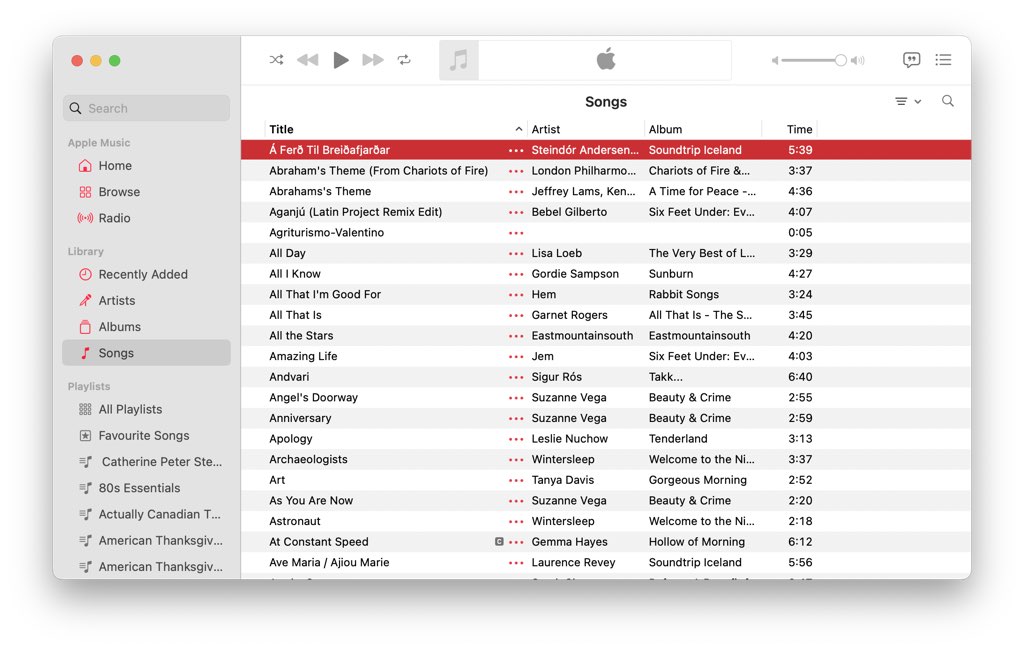
One Thing is an email newsletter subtitled “Good things, real things, interesting things”, and it generally delivers on the promise.
In the recent Boutique Dreams, the book Shopkeeping, by Seattle bookseller Peter Miller is the focus:
Peter Miller might be the cultural embodiment of if you know, you know, and I have to admit, I did not know. He is the owner of Peter Miller Books, an architectural bookstore and purveyor of quality objects in Seattle that has survived for more than 40 years. I’ve never been there, but I feel like I have, because I read Miller’s new slim volume Shopkeeping: Stories, Advice, and Observations, which is a manual slash memoir that contains his philosophy of retail. You know I love a slim volume, and this is a beautiful one. Bound in thick, gray linen paper, with a sketch of the storefront on the cover, the book is an objet in itself. Over its scant 136 pages, in airy, straightforward paragraphs, Miller makes the case that shopkeeping is a kind of meditative art form, a holistic practice that requires not just enlightened taste but intense discipline, thinking about everything all the time.
Of course I ran to The Bookmark and bought myself a copy immediately. It is indeed a delightful book, a paean to the sort of shop I love dearly, the sort of shop that is increasingly rare.
Many years ago there was a Grabbajabba coffee shop on Kent Street in Downtown Charlottetown (it eventually became a Timothy’s, and moved around the corner to Great George Street, where it remains). My friend Eugene Sauve was a partner in the enterprise, and I recall a conversation once where he relayed to me a chat he’d had with Chen, owner of the late great Formosa Tea House. Chen led Eugene out to the sidewalk and told him about the importance of the “face” of the shop, the way that it presented itself to the street.
I thought of conversation when I read Miller’s word’s about the how a shop exists in the urban context:
As a shopkeeper, you have a quiet, unspoken responsibility to your literal section of the street. You keep quiet track of it and help, however you can.
I find it remarkable that I encounter many shops who, after having invested all manner of time, energy, and money in creating a small business, seem unable to inhabit the business from the perspective of a customer or neighbour. And yet, as Chen told Eugene, and as Miller writes, it is your face, and among the most important things you can nurture.
Miller again:
A good shop takes its direction from the existing space—where is the natural light, how does it change, what will it affect? You may decide to block the view to the street, to create privacy and enclosure and give yourself a true stage for a shop window. That is the typical department store solution.
Or you may want to leave the window as a visual access into the store, declaring yourself in a most open and clear way. There are advantages to both solutions, but there are consequences as well.
You must go outside your shop and look at it-in every season and at many different times of the day. It is literally how you look and how you are perceived.
Shopkeeping is a book any shopkeeper would do well to read and inhabit.
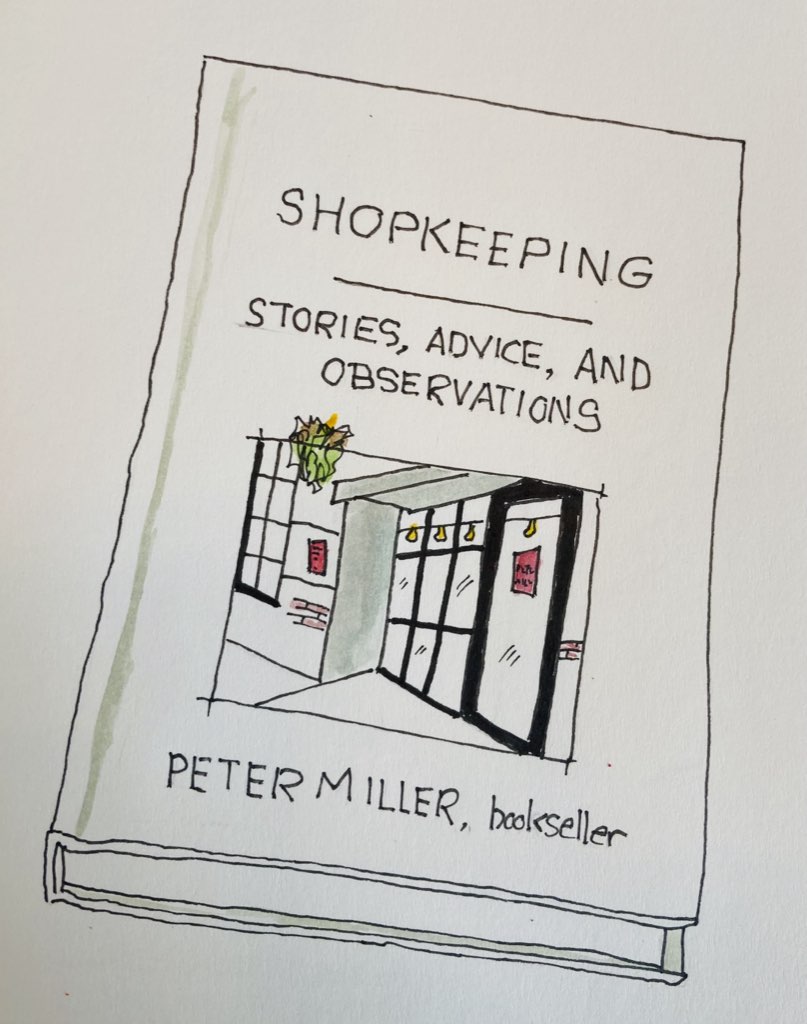
The July edition of our This Box is for Good box was as complete a departure from our June box, in theme, execution, and result, as you can imagine. June was abstract and typographical; July was a rendering of Kinlock Beach. We’re both very happy with the result: it was a complicated multi-layer, multi-block reduction linocut, and we had new successes at registration and workflow. You can read the account of the box to learn more.
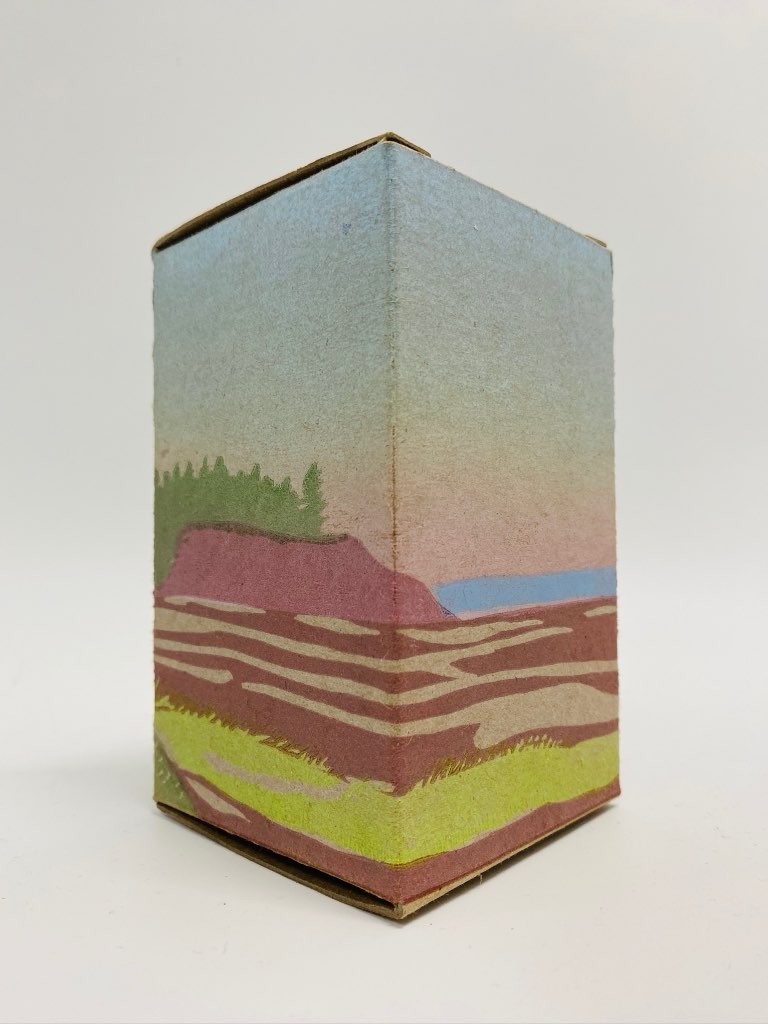
We’re behind on the process of documenting our monthly This Box is for Good boxes, but we’re slowly catching up. A few weeks ago I posted the play-by-play for our June 2024 box. It is one of my favourites, in part because it flowed from a collective river of imagination, in the studio, in the moment. We’ve distributed the entire varied edition already, but you can request a free box of a future edition at thisbox.info/request.
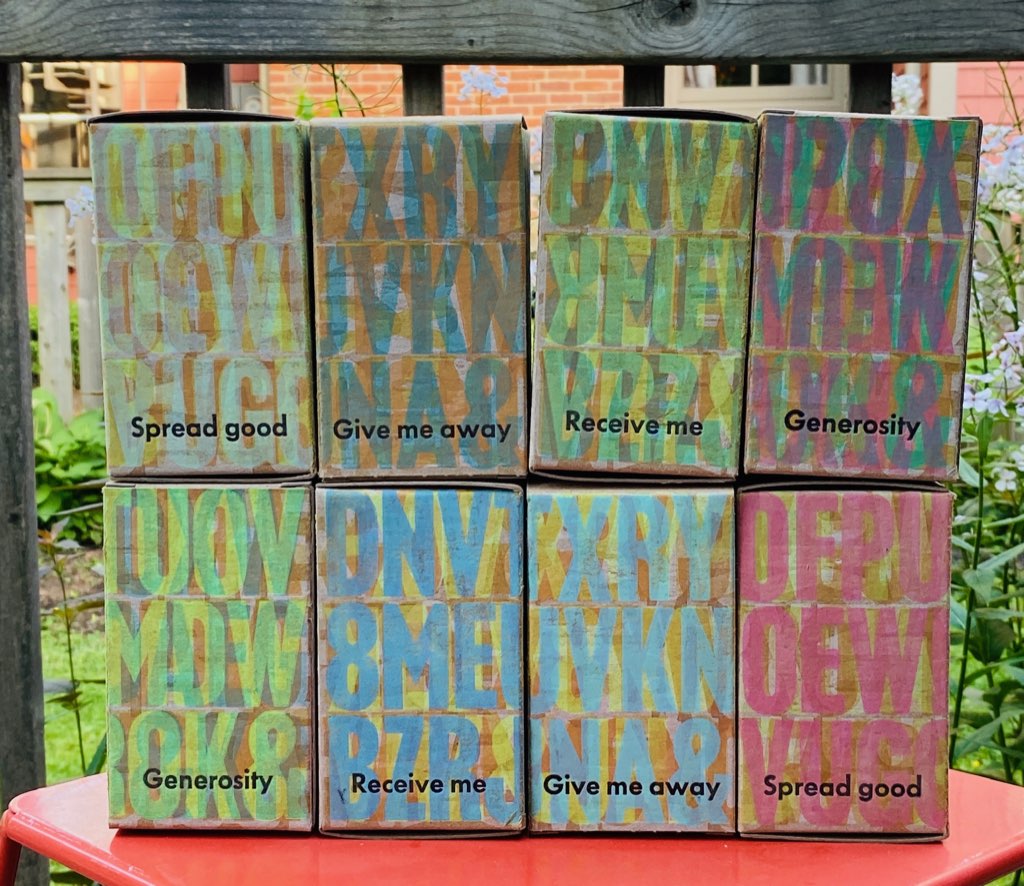
This morning we woke up at the shore with four teenagers expecting pancakes for breakfast, and no eggs in the pantry.
At Lisa’s suggestion I texted our neighbour to see if he might have a few, and he quickly texted back that he’d leave them on his porch for us.
A few minutes later, still in my pyjamas, I ambled over to retrieve them.
A simple everyday story, yet one packed with enough divergence from my past norms as to boggle my mind a little.
In my coaching work over the winter I returned often to the idea of having a personal “rule book” — “you never go outside of your house wearing pyjamas” might be one rule, for example — and my coach ultimately led me to the conclusion that rather than engaging in a rule winnowing exercise, I might just as well throw out the notion of having a rule book itself.
This morning’s pyjamas eggs mission was part of that project.
Almost exactly four years ago this week came the Refrigocalypse. COVID was freshly at our heels, the world’s supply chains had shut down, and my refrigerator, my specifically-sized, hard to find a replacement for at the best of times refrigerator, had stopped working.
After trying some DIY solutions, I threw up my hands and ordered the one fridge that was the right size that I could find in Charlottetown. And it’s been there since, dutifully serving us with its cooling magic.
Last summer there was a break in the cooling, rectified by some mystical incantations, a vacuuming of the coils under the fridge, and a period of contemplative silence. That fixed it.
This summer, no such luck.
We’ve been staying up the street at my brother and sister-in-law’s house, helping care for their cat while they’re away. While we’ve been away from our fridge, we’ve been hosting home exchange guests, and the guests reported that, upon leaving on Sunday, while the freezer was fine, the fridge had stopped working.
I returned for some more mystical incantations, and this appeared to work. Bullet dodged. But then the problem reoccured yesterday, and I scrambled to bring in professional help.
My first call, to our usual appliance repair guy, revealed that he was booking into next week (I asked the person who answered his phone if she could recommend someone else; her reply was “well, he’s my grandson, so I usually just call him.”)
Another call, another booking-into-next-week.
I tried the Whirlpool website, where, I remembered, I’d registered the fridge when I’d purchased it in 2020. This looked promising: the record of the fridge was there, and there was a button to request service. When I clicked the button, however, it turned out that the website to request service for your broken fridge was itself broken:
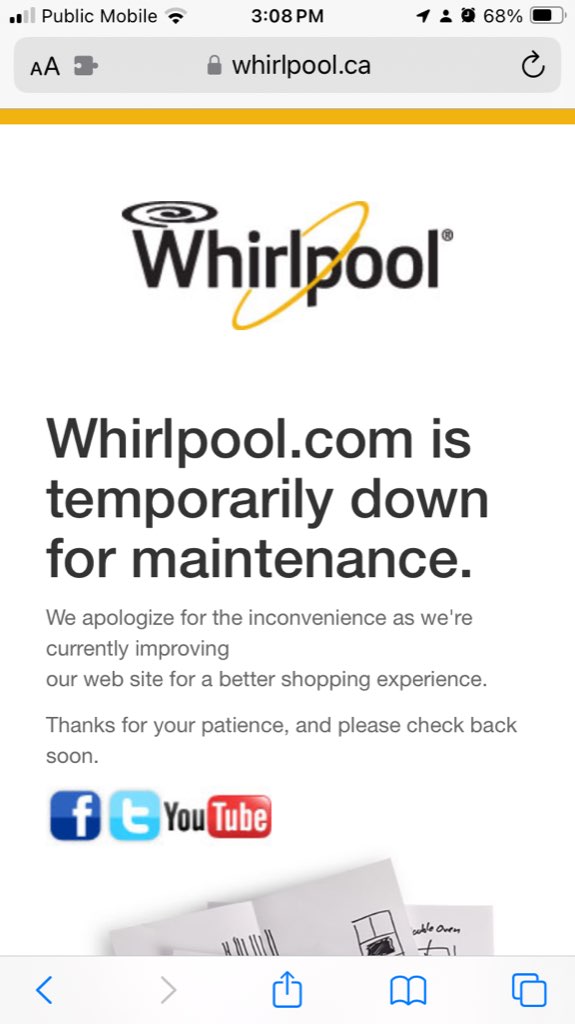
Finally I did what I should have done in the first place, and called Birt’s Furniture, where I’d bought the fridge, and asked them for referrals. They suggested I call Matt Dollar, which I did. I left a message; Matt called back 20 minutes later, and told me he could be over in the morning.
This morning he called when he was 10 minutes out, and we met at the house as scheduled.
The diagnosis: the fridge isn’t defrosting properly, likely due to a faulty “jazz board,” the electronic control board that manages this feature among others. He would need to order one from Ontario, and, while we’re waiting for it to arrive, he recommended leaving the fridge off for 24 hours to let it defrost all on its own, after which it should have enough get up and go to get us through to install date.
Stay tuned.
This morning’s workout of the day at Kinetic was a 25 minute AMRAP (as-many-rounds-as-possible). It was hard: 9 back squats, 12 push-ups, 15 box jumps, 21 sit-ups. Repeat. It took everything I had to do 6 rounds.
In the middle of the workout, in the middle of a round of box jumps, I yelled out:
I LOVE BOX JUMPS
Because what choice did I have?
I either love jumping up from the ground 20 inches to the top of a plywood box, or I don’t.
And if I’m going to do it 90 times in the space of 25 minutes, loving it is a way more helpful attitude.
The awards for the 2024 edition of Island Fringe were presented last night, and among them was The Oscar Wilde Award, which I sponsor every year, presented to the show that “most effectively celebrates non-conformity.”
This year the jury selected the show So an Autistic Priest and Dog Walk into a Bar…, written and presented by Jean-Daniel O’Donncada, described in the program as a “storytelling emotional comedy about autism, religion, and love, with a dog,” and with this “accessibility note”:
The show is 60 minutes long. It is sensory sensitive with no loud surprises, and no dramatic or changing lights. There is a live dog present throughout the show. Attendees with service dogs are encouraged to come a bit early so all dogs may be aware of each other’s presence before the show begins.
In previous years I’ve prided myself—and benefited greatly—from seeing all, or almost all, of the shows at each year’s Fringe; this year, however, circumstances meant that I saw only a single show, After the Chorus Line.
Olivia, however, did see O’Donncada’s show, and spoke highly of it, and the reaction to the award from the audience last night (and for both the Patrons’ Pick and Artists’ Pick awards that followed, both of which also went to O’Donncada), suggests it was a deserving recipient. As does his biography:
I’m openly, and sometimes unashamedly, Christian, Québécois, Canadian, queer, autistic, and awkward. I get particularly passionate about making sure church and society do better at welcoming those who speak minority languages and those who think in marginalised, neurodiverse ways.
I wrote in my note to the award winner:
The world needs—demands—more of the non-conforming, and that’s why I sponsor this award. Please continue. And, when you are able, pay if forward.
I have every reason to believe that Jean-Daniel O’Donncada will do exactly that.
We got up early this morning to go for a bicycle ride, before it got too hot.
I remembered that the City of Charlottetown had extended the Riverside Drive/Bypass active transportation pathway from Brackley Point Road to Mount Edward Road, and thus the Confederation Trail.
This meant we could do a counter-clockwise 13 km loop around the city, most of it on a separate path, with a bonus of being able to stop at the Charlottetown Farmers’ Market on the back stretch.
In August of 1990 I drove from my home in Peterborough, Ontario, 3,400 km southwest to El Paso, Texas, to take up a post as a nanny for a few months.
We were driving in a convoy: Leslie, mother of my 2 year old charge, an aspiring midwife (El Paso being a hotbed of midwifery education) was driving her mother-in-law’s VW Vanagon, and I was driving my 1980 Toyota Tercel. Leslie’s van had air conditioning. My Tercel did not.
This was in a day before most cars had air conditioning, so this wasn’t unusual. I’d certainly never owned a car with AC, and maybe only the 1975 Dodge of my father’s, the one with velour seats that got totalled in a not-my-fault accident when I was 16 and driving home from my job at Canadian Tire, maybe only that car was the one with AC in my life to date at that point. And, of course, the Vanagon, which I was occasionally allowed to swap into, switching places for a respite from the heat.
The heat came to a head as we stopped in Nashville for a muffler job on the VW. I remember clearly the temperature on the sign outside the muffler shop showing 100ºF (38ºC), and that was without factoring in the humidity (the Almanac validates my memory).
Driving when it’s that hot, you drive with all the windows open and with the fan on full blast, hopeful that somehow blowing blistering hot air over your body will make it feel less blistering hot (it doesn’t).
By the time we got to El Paso a few days later, it was a comparatively balmy 87ºF (30ºC). Cold enough, in fact, the outdoor swimming pools were closed up for the end of the summer, because it wasn’t deemed hot enough to swim.
I love most things about my 2016 Kia Soul EV, but its air conditioning system isn’t one of them. I put $400 into it a couple of years ago; when the AC stopped working again at the start of this summer I got an estimate of $1,300 to repair it, and decided that I had better things to spent that money on, so opted to leave it broken.
It’s been a hot, hot summer, with more heat warning days than not, it sometimes seems. And so this summer, bopping around the Island in my Soul, has felt a lot like that trip 34 years ago down the heart of America: windows open, radio blaring, blistering hot air masquerading as something it cannot and never will be.
 I am
I am